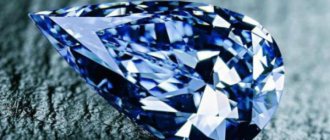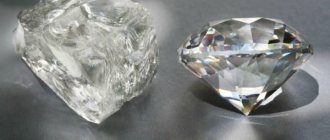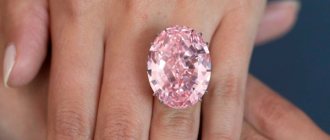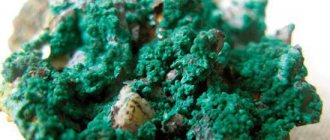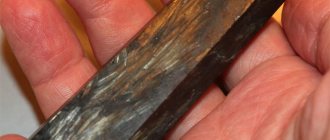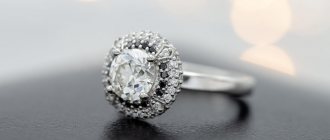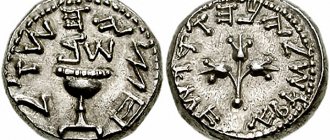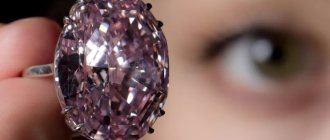Colored diamonds are quite popular among jewelers. They are rarely found in nature, so their cost is high. Experts identify several basic shades: red, yellow, black, green. As a rule, jewelry with such stones is ordered individually. The purchase can cost more than one million dollars. What is the beauty of colored diamonds, we will find out in the article.
When did colored stones appear?
A diamond is a stone that has always been valued. Millions of women dream of having jewelry with it. Such gems are quite expensive. Colored diamonds are distinguished by their beauty and magnificence. Their existence has been known since ancient times. Historical documents contain references to a stone that amazes with its brilliance and originality. It is reliably known that Russian tsars, French rulers, for example, Ludwig XIV, as well as other famous monarchs had jewelry inlaid with colored diamonds in their caskets. Since technical progress was then at a low level, all stones were of natural origin. This made them even more valuable and expensive.
What makes a diamond colored?
Many people are interested in the question: “How are colored diamonds formed?” Experts assure that this is a long process. Many factors are necessary for a stone to acquire one color or another. The process has not yet been thoroughly studied, but the general picture looks like this:
- The stone gets its pink tint from being deep underground. This is facilitated by a certain temperature and pressure. As a result, the crystal lattice is slightly deformed and absorbs the green color. When a diamond is discovered and brought to the surface, what is reflected is actually a pink hue.
- The stone gets its blue color thanks to boron. This component changes the structure and color of the diamond.
- Green stones are among the most expensive. Experts do not fully know the history of their formation. It is believed that it all comes down to physical factors (certain temperature, pressure, humidity) in the upper layer of the earth’s crust.
- The purple tint appears due to deformation of the crystal.
- A diamond turns yellow thanks to nitrogen.
Colored diamonds, photos of which are presented below, are of natural origin. Their cost is quite high. In jewelry stores there are practically no products using such stones. Jewelry is made to order.
Origin story
The chemical composition of diamond is primitive - it is the purest carbon. Much cheaper and more common substances - graphite and coal - have a similar composition. However, they have a fundamentally different crystal lattice structure, and therefore lack diamond hardness and brilliance.
Diamond is the hardest substance on Earth, taken as the starting point on the Mohs scale. Many chemists and physicists are of the opinion that it is impossible to create a more solid substance even in laboratory conditions. The only exceptions are the descendants of diamond that are modified at the molecular level.
For a long time it was believed that diamonds were born in rivers - this is where our ancestors found these stones. But a couple of centuries ago it was proven that these marvelous stones are products of fundamentally different processes occurring over hundreds of billions of years. However, debates about the nature of the origin of diamonds are still ongoing.
Modern science believes that diamonds are formed in the Earth's mantle. At a monstrous depth, in the depths of our planet, under the influence of high temperatures and incredible pressure, carbon atoms form a special cubic crystal lattice. These are diamonds.
Over millions of years, during volcanic processes, future diamonds gradually rise into the earth's crust, and sometimes are brought to the surface. Most gem-quality diamonds are mined in so-called kimberlite pipes.
Gold pendant “Diamonds of Yakutia” (go to the SUNLIGHT catalogue)
There are also special “impact” diamonds. According to most theories, they were formed several billion years ago as a result of a supernova explosion in a distant corner of the Galaxy and arrived on Earth along with meteorites.
Impact diamonds, although stellar in the literal sense of the word, are not distinguished by their transparency and significant size. They are usually used for technical needs.
The age of the “youngest” diamond is at least 100 million years. And not every stone is destined to turn into a diamond. There is the following classification:
- Jewelry diamonds. Relatively large stones that can be cut and used in the production of jewelry. These stones have a minimum of inclusions, are transparent and, after cutting, turn into diamonds.
- Industrial diamonds. Small, cloudy, damaged stones that are used for technical needs (mainly for the production of abrasives, cutting, drilling and drilling equipment)
- Board. This is essentially diamond chips. There is a jewelry bead, which is used to decorate jewelry, and a technical bead, which is used in production like other diamonds of the corresponding group.
Currently, diamond mining is carried out in more than 40 countries around the world, and the reserves of this stone are gradually depleted. The most impressive diamond reserves (of those discovered) are located in a number of African countries, Canada and Russia.
About a quarter of the world's diamonds are mined in Russia. The largest deposits are located in Yakutia, near Arkhangelsk, in the Perm region. Most Russian diamonds are mined in Yakutia, but only 20% of them become diamonds. But the Permian deposits produce about 90% of gem-quality stones.
Scientific developments
Technical developments do not stand still. Many scientists have worked for years to artificially create colored diamonds. In the end, they succeeded. I would like to note the fact that the cost of stones is not very different from those created by nature. The thing is that laboratory-grown diamonds are not used. As a rule, a natural stone is taken whose color is not sufficiently saturated, and with the help of high technology the color is made brighter. For this purpose, special conditions are created for the stones: temperature and pressure.
Another method is called irradiation. Energy particles will already be involved here. Such processes are carried out only in closed laboratories. It is very difficult to acquire real colored diamonds. In recent years, many stones grown artificially in laboratories have been passed off as natural on the market. The cost is correspondingly very high. To understand the origin of a diamond, it is necessary to submit it for a gemological procedure.
What properties do rocks have?
Knowledge of the properties of natural resources allows us to divide them into groups and varieties and determine how to use them. The characteristics of rocks are divided into 2 categories: chemical and physical. Chemical are those that appear as a result of chemical reactions or influence their course.
These include:
- list of substances included in minerals;
- ability to interact with acids and alkalis;
- decomposition rate;
- type of crystal lattice.
Chemical properties cannot be determined by external signs. Substance studies are carried out in special laboratories. Physical characteristics depend on the composition and structure of the stone. The table provides a description of the main properties.
| Properties | Description | Feature Options |
| Color | Determined by appearance. Rocks take on the color of their constituent minerals. |
|
| Transparency | Rocks are opaque because they are made up of different components. However, the crystals included in them may be transparent. |
|
| Shine | Reflectivity of the mineral. |
|
| Magneticity | Depends on the presence of unpaired electrons. |
|
| Radioactivity | The ability to absorb and release radiation. | Determined depending on the radiation intensity. |
| Mechanical | Resistance to external influences. |
|
| Hardness | Determined by the density of the crystal lattice. The Mohs scale is used to determine the hardness of individual minerals. | Rated from 1 to 10. Talc – 1 point, diamond – 10 points. |
| Density | Defines the weight of the instances. |
|
| Thermal conductivity | Also found in individual minerals or monomineral fossils. |
|
The minerals that make up the rock are also characterized by other characteristics. These include:
- stroke color;
- fracture options;
- cleavage;
- electrical conductivity;
- boiling and melting points.
The mystery of the black stone
Colored diamonds have become quite popular recently. There are many auctions where stones are offered for high prices. The black diamond has the greatest mystery. Previously, it was believed that the stone had no value, but times have changed. Now they are ready to pay fabulous sums for the “black king”.
This stone is believed to be of extraterrestrial origin. It's all about its medicinal properties:
- Perfectly helps to cope with nervous breakdowns and depression.
- Relieves drug and alcohol addiction.
- Relieves fever.
- Removes inflammatory processes in the body.
The black diamond is truly a mystery of nature. So far, scientists have not been able to grow it artificially.
The best
There are truly famous colored diamonds, the cost of which is amazing:
- "Orange Pumpkin" Halle Berry wore a heart-shaped ring during the Oscars. The cost of the stone is 3 million dollars.
- Ring with a pale green stone called DeGrisogono. The cost of the central diamond is $7.3 million.
- The ring, encrusted with red triangular diamonds, became one of the most expensive on display at the Smithsonian Institution. The price of the stone is 7 million dollars.
- Another diamond was discovered not long ago in the mines. It is shaped like a heart. Has a soft blue tint. Its cost is estimated at $16 million.
Nature does unique things. Diamonds become a real decoration for many women. Colored stones are so popular that men are willing to work day and night to please their significant other.
What to prefer - color or clarity
Color and purity are two important criteria that indicate the quality of precious minerals. On the tag they are placed side by side in the form of regular numbers. The first point is given to color, and the second to purity, and it is problematic to understand exactly which of these indicators should be better.
When choosing, the following circumstances are taken into account:
- Priority is given to color if a specific setting is provided for the gemstone. If the frame is white, then visible shades are extremely undesirable. In this combination, the yellowishness will be pronounced.
- Clarity is important if the stone is to be set in yellow gold. This metal will absorb the yellowness. The mineral will visually appear white. True, if its quality is low, the dirt on it will become pronounced. The gem should look absolutely clean.
Some tips
When buying a ring with colored diamonds, you need to know the following nuances:
- First of all, you need to be especially careful when purchasing stones of yellow, brown, or green shades. The thing is that they are easiest to refine in the laboratory, making the color richer and brighter. To ensure the authenticity of the stone, it is better to submit it for gemological examination. The conclusion will be a guarantee of quality.
- To correctly determine the cost, ask the laboratory to give an accurate color description.
- It is better to make custom-made products individually.
- Try to purchase stones from cutting companies, and not from resellers.
Colored diamond jewelry is considered an indicator of status and luxury. They are quite popular among high society. Their cost is high. But even among them there are fakes: stones grown artificially. There is no need to skimp on expertise. It should be a mandatory procedure before purchasing a colored diamond.
Classification
Current breakdown of processed crystals by category:
- elite - fancy, bright, richly colored crystals without nitrogen impurities;
- Cape - yellowish brown, cognac stones, the structure of which contains nitrogen molecules. Due to this impurity, transparency deteriorates and density decreases. This reduces the quality of the stone somewhat.
Classification by color:
- champagne - light, almost yellow specimens with an additional tint;
- brown - most common;
- chocolate - the rarest;
- cognac ones are the most interesting for the public, as well as the most famous (the entire group is named after this color).
In certificates for crystals, color is described by gradation from very light champagne to dark cognac.
Precious crystal
In everyday life, when describing color, they resort to associations - they compare the color of a stone with honey, hazelnuts, gold, bronze, walnuts, coffee beans, cinnamon.
Black and brown diamonds are divided into categories based on their properties and quality, taking into account the richness of their tonality. The more intense the shade, the more expensive the specimen.
From stones to rodents
Recently, colored stones have become so popular that many savvy marketers are using them as a brand. Thus, a nursery for colored chinchillas, “Brilliant”, was opened in Yaroslavl. The bright name does not leave lovers of furry rodents indifferent. The colors of chinchillas are truly amazing and mesmerizing. Look at the ashy or pastel shade of rodents!
Returning to the issue of stones, I would like to note that jewelry with colored diamonds are quite expensive. It is better to purchase products to order. Do not forget to undergo a gemological procedure and receive a certificate confirming the natural origin of the stone.
